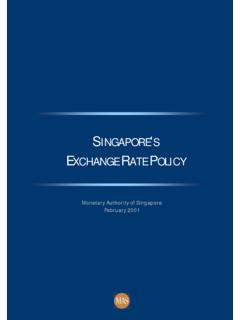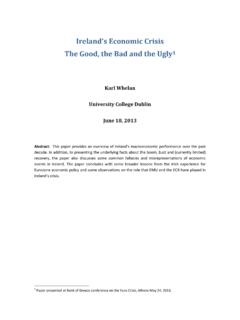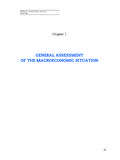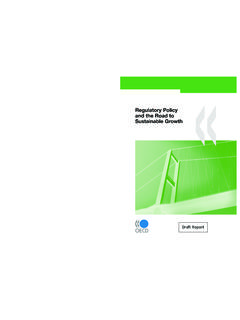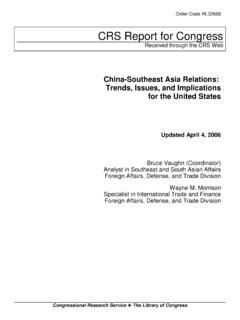Transcription of Economic policy and outlook - treasury.gov.za
1 172 Economic policy and outlook The world economy is emerging from a deep and synchronised recession precipitated by the financial crisis in developed countries. Recovery is likely to be slow and uneven, with modest global growth projected in 2010. South Africa is also recovering, but at a slower rate. While positive fourth-quarter growth is projected, the economy is expected to contract by per cent overall in 2009. Gradual recovery will see the economy realise growth of per cent in 2010, rising to per cent by 2012. Government and the Reserve Bank have adjusted fiscal and monetary policies to support domestic demand, while public expenditure on key social priorities and infrastructure investment has been maintained.
2 The recovery will strengthen as business confidence improves, employment stabilises and household incomes start to rise. Over the next few years, the best-performing emerging-market economies will boost their efforts to increase productivity and competitiveness, and South Africa must do the same or risk being left behind. The crisis provides us with an opportunity to improve the efficiency of public spending, expand investment opportunities for the private sector, and reorient the economy onto a more labour-intensive growth path. The outlook for growth The most far-reaching Economic crisis since the 1930s was set in motion by the collapse of the subprime housing market in the United States.
3 When the bubble burst, the massive exposure of the financial system to bad debt led to a seizure in global credit markets. A systemic collapse of banking systems in developed economies was only averted through large-scale, coordinated government intervention during the fourth quarter of 2008. These events brought on a global recession, sharply curtailing trade, investment and employment. The global recession has sharply curtailed trade, investment and employment 2009 MEDIUM TERM BUDGET policy STATEMENT 18 There are, however, growing signs that financial stabilisation and Economic recovery are taking root.
4 The International Monetary Fund (IMF) expects world growth of per cent in 2010, after a projected contraction of per cent this year. In South Africa, the global downturn led to the first recession in 17 years. Following a decade of uninterrupted growth, real GDP growth contracted by 2 per cent in the first half of 2009. The world recession coincided with a range of negative domestic developments that contributed to the depth of the present downturn. These included a debt-fuelled consumption boom, followed by a surge in inflation during 2007 and 2008, which reduced competitiveness and pushed up interest rates.
5 In addition, key infrastructure such as electricity generation could not keep up with demand. The recession has had a severe impact, with increased hardship felt by millions of South Africans. Nearly half a million people employed before the crisis struck are now without a job, and a growing number have been squeezed between falling incomes and high levels of debt. Domestic fiscal and monetary policies have been eased substantially over the past year to support communities and bolster demand. The fiscal deficit has increased to per cent of GDP, while the repurchase rate has declined by five percentage points since December 2008 to 7 per cent, leaving real interest rates close to zero.
6 After an estimated contraction of per cent in 2009 as a whole, the economy will recover gradually over the medium term, driven by positive investment growth, more stable inventories and slower, but still positive, growth in government consumption. Spending on stadiums and transport associated with the 2010 FIFA World Cup has already boosted growth, and the main event next year will further benefit tourism and tax revenues. Real GDP growth of per cent is projected in 2010, rising to per cent by 2012. In the period ahead, South African producers will benefit from a recovery in global demand and high commodity prices, largely as a result of growth in China and India.
7 Renewed capital flows to emerging markets will also reduce the cost of capital and finance fixed investment. Continuing public-sector investment in Economic infrastructure provides crucial support to the recovery and is essential to reduce bottlenecks and draw in private-sector investment. Real fixed investment by public enterprises is projected to grow by about 17 per cent per year over the medium term. Low inflation, a more competitive real exchange rate, and rising private-sector investment and employment are important for a stronger recovery. CPI inflation declined gradually to per cent in August 2009 as food and petrol prices moderated, but core inflation remains above 8 per cent.
8 CPI inflation is projected to average per cent in 2009, trending downward to per cent in 2010 and reaching per cent by 2012. The primary factors driving inflation next year will be higher electricity tariffs and efforts by producers to recoup profits as demand recovers. Financial stabilisation and Economic recovery are starting to take root Nearly half a million South Africans have been retrenched over the past year Public-sector investment programme supports growth and medium-term recovery CPI inflation, at per cent in 2009, is expected to trend downwards CHAPTER 2: Economic policy AND outlook 19 Household consumption will recover gradually.
9 There is limited appetite for new debt and the labour market will remain weak until growth strengthens. Household consumption is projected to grow by per cent in 2010 and per cent in 2011. The current account deficit will decline to an estimated per cent of GDP in 2009 from per cent last year. However, the deficit is expected to rise to per cent in 2010 and per cent in 2011, reflecting stronger growth in domestic expenditure and international investment in domestic markets. Table Macroeconomic projections, 2009 20122006200720082009201020112012 Calendar yearActualEstimateForecastPercentage change unless otherwise indicatedFinal household Final government Gross fixed capital Gross domestic Real GDP
10 GDP GDP at current prices (R billion)1 1 2 2 2 2 3 CPI Current account balance(percentage of GDP) Table Macroeconomic projections, 2009/10 2012/132006/072007/082008/092009/102010/ 112011/122012/13 Fiscal yearActualEstimateForecastPercentage change unless otherwise indicatedGDP at current prices (R billion)1 2 2 2 2 2 3 Real GDP GDP CPI Prospects and risks in the global recovery The events of the past year illustrate the dangers of laissez-faire economics, in which financial systems are allowed to operate without prudential supervision and regulation.










